#african visual culture
Text

Young Nigerian woman in the late 1950's, photographer unknown
#style#nigeria#photography#photographie#art#photographie contemporaine#contemporary photography#african visual culture#visual culture#curation#research#manufcatoriel
354 notes
·
View notes
Text

Traditional marriage today in Nigeria.
Groom from akwaibom
Bride from Arochukwu in abia state
#arochukwu#abia#abia state#nigeria#akwa ibom state#igbo#traditional clothing#kemetic dreams#afrakan#africans#brownskin#afrakans#brown skin#african#african culture#traditional#visual arts
26 notes
·
View notes
Text
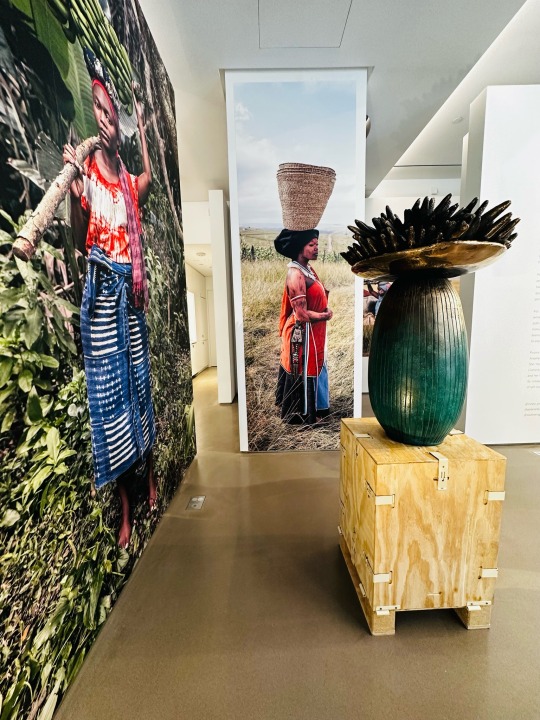
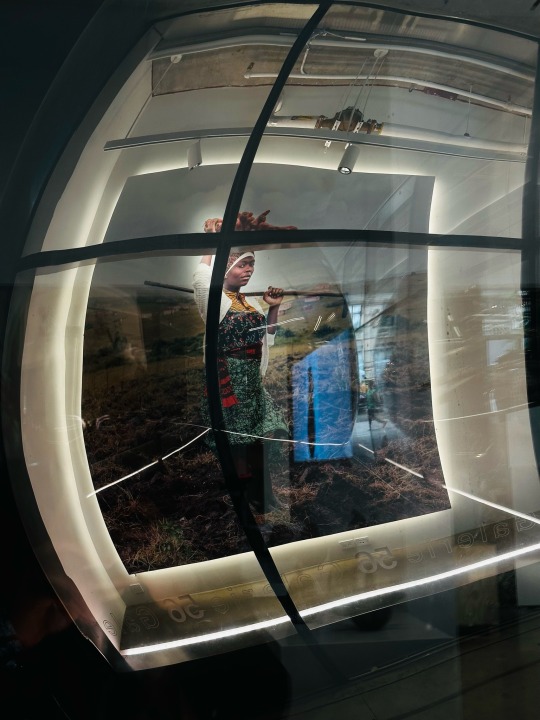

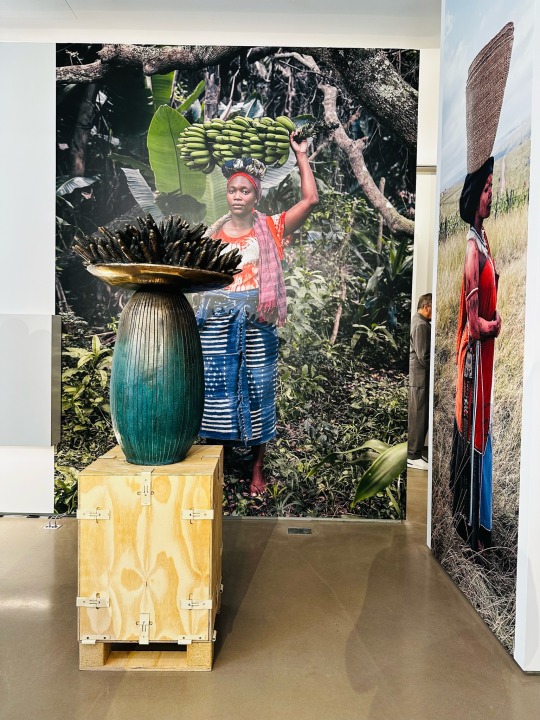
Pillars of the Nation
#installation#conceptual#minimal interior#space#detail#manhattan#time#critic#nyc#gallery#galerie56#exhibition#visual#modern#artist#art#black#African#African art#culture#heritage
3 notes
·
View notes
Text

COLLAGE ON VIEW
The Woods Women & Other Works
Saya Woolfalk at Leslie Tonkonow Artwork + Projects in New York, New York, USA through 23 November 2022. Saya Woolfalk creates works of art that combine elements of her African American, Japanese, and European heritage, with allusions to anthropology, feminist theory, science fiction, and Eastern religions. In this exhibition, Woolfalk introduces “The Woods Women”, a secret society that predates her Empathic Universe. The exhibition includes the artist’s newest works on paper, inspired by her study of the renowned Hudson River School and herbarium collections at The Newark Museum of Art where she was the Artist-in-Residence in 2019. MORE
*****************************
Kolaj Magazine, a full color, print magazine, exists to show how the world of collage is rich, layered, and thick with complexity. By remixing history and culture, collage artists forge new thinking. To understand collage is to reshape one's thinking of art history and redefine the canon of visual culture that informs the present.
SUBSCRIBE | CURRENT ISSUE | GET A COPY
SIGN UP TO GET EMAILS
#collage#collage art#collage artist#art#artist#art history#art project#contemporary art#artwork#art show#art books#art education#modern art#fine art#artist profile#artist book#artist portfolio#contemporary artist#artist residency#art collage#paper collage#digital collage#collage painting#collage book
3K notes
·
View notes
Text
I'm only halfway through this show myself, but I really want to urge everyone to check out KIZAZI MOTO: GENERATION FIRE, because I haven't seen a lot of people talk about it and I really think more people should be giving it a shot.
It's an anthology series of 10 short stories, each about 10 minutes long. Every episode has a different beautiful art style and was made by a different African creator.
What they all have in common is the visually intriguing and unique Afrofuturism genre, intertwined with African mythology and cultures.
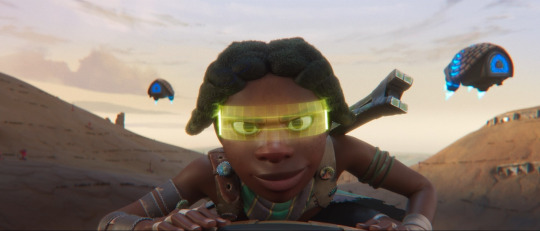
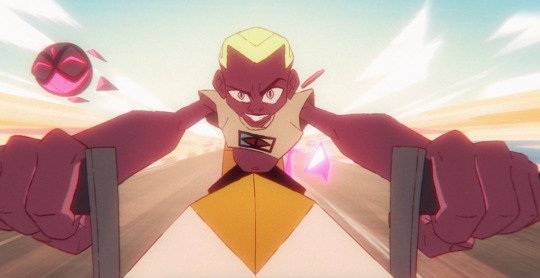
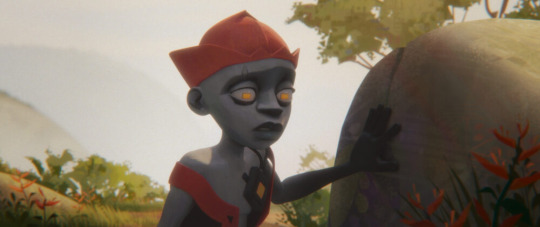
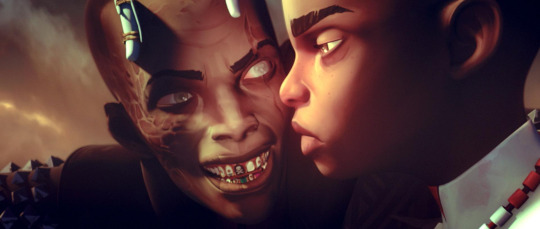
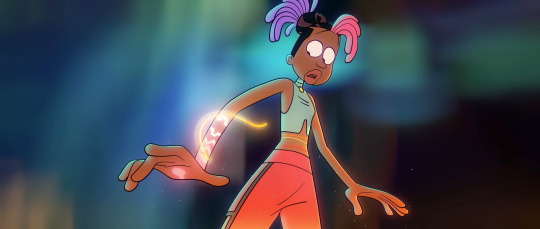




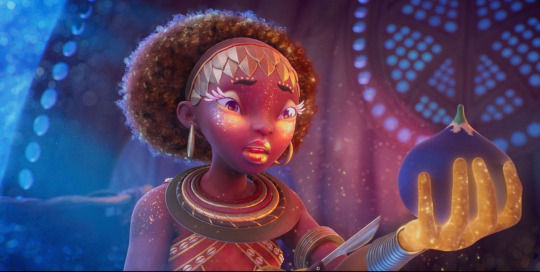
933 notes
·
View notes
Text
Shango's Thoughts:
Stop mixing & matching spiritual ideas (New Age Nonsense is Still Nonsense)
So, can we talking about how this is NOT a 3rd Eye?

Just because you see a singular eye, does not make it a 3rd Eye by default.
This is actually the Eye of Ra & it's actually the right eye. It's paired (pair = 2) with the Eye of Heru which is the left Eye.

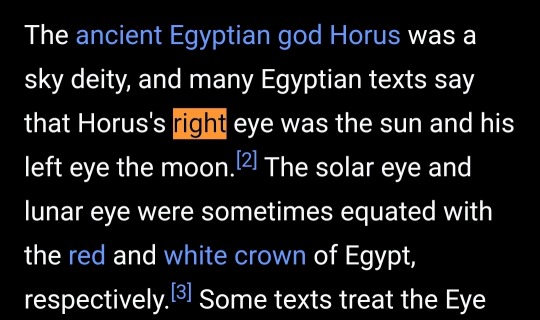

The Eyes are actually Falcon eyes, because both the deities to whom these eyes belong are sky deities, both represented by the falcon. That is because the falcon not only has excellent eyesight, but it soars far above any & everything else, which allowed them to see farther than any other living creature..
One eye represents divine insight, the other represents divine foresight.
As an African society, Ancient Kemet (Egypt) was a nature-based society.
This is important, because, like all African societies (ancient & modern), they did not deviate from the divine principles of nature. In fact, they revered, & was greatly inspired & empowered by it. This was greatly reflected in their symbology.
As such, they understood that there neither was, nor is, any creature in nature that possesses an odd number of eyes. Every creature has an amount of eyes that are divisible by 2.
The idea of 3 eyes in African culture & Spirituality would therefore be seen as unnatural.
So where does the idea of the 3rd Eye come from?
It comes from Hinduism & Buddhism.
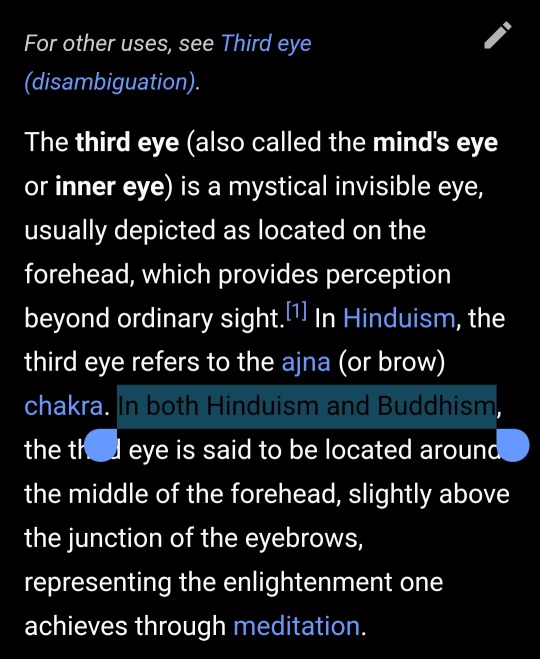
I've mentioned this a few times on my page, but whenever I see people (especially Black people, as that's essentially all I care about 🤷🏿♂️) talking about 3rd Eyes, & especially using the All-Seeing eye(s) as a visual representation of the 3rd Eye, I automatically know it's being done out of ignorance.
The reality is, most Black people don't know enough about Hindu beliefs, the nuances of their culture, nor their language to glean any real spiritual benefit from this concept. The proof of this lies in 2 points:
1) If they did, they wouldn't be mixing & blending it with African Spiritual concepts, &
2) They'd know that India is a very anti-African culture & society.
Not to mention, the meanings of the "Eye" in both cultures do not run congruent. Their meanings are not remotely similar.
So, how did Black folks get this notion of the 3rd Eye in the first place?
The answer is both complex & simple.
Hindus don't teach it, because A) they are very insular about their culture, & B) they wouldn't teach it to black people, because Hindus are extremely anti-Black.
I know Black folks like to make the false Pseudo claim that India & Africa are culturally linked, but nothing could be further from the truth (I've spoken many times on here about this; refer to my posts under "#Shango's Thoughts").
The simplest answer is, it came from white people.
Without going into great detail (at least, not at this time): The New Age Movements that were sparked by white people from Europe, as early as the 1930's.
These white people were seld proclaimed "mystics" that dabbled in all sorts of spiritual ideas, that made their way to the US when these same Crackas migrated to the US.
Many of them were affiliated with the Nazis, which is where they got their hatred of Black people. As an example of the correlation, that's why you see the swastika as the symbol of Nazism.
One such white "mystic" was Helena Blavastky:


This is the "mother" of New Age Spirituality (along with a few others of her ilk).
What's sad, is that alot of her ideas influenced everyone from Hitler to many of the Black spiritual movements in Amerikkka, from. The NOI, to 5% Nation of God's & Earth's, to the Nuwaubians, to the Moors, & a few others. Most of them don't even realize it, because they are not academic enough to make the connections.
I could go deeper into this now, but I won't (again, not at this time). The bottom line is, you can talk about how terrible these people are all you want, but the truth is, yall get all your "info" from them.
Suffice it to say, most Black people have been convinced to take part in ideas like Chakras & 3rd Eyes (& other related concepts, such as "Pineal glands"; again, not an African concept) because they've been influenced by white people.
Ideas like chakras, 3rd Eyes, Angel numbers, tarot cards, & a host of other concepts that have caught on in the past 50yrs are nothing but recycled racist notions. They have nothing to do with African culture or Spirituality.

Europe, France, Italty, Austria, Germany.... You haven't seen a Black face or name yet. 🙄
I cannot tell anyone not to hold fast to these ideas; you are free to do whatever you wish. But I can tell you one thing....
Whites & Hindus are laughing at us when we regurgitate these ideas.
I can also tell you why I do not adhere to them..... They are not from our Ancestors. They are from our enemies. Any religion that comes from your enemy (be it directly or indirectly) has no spiritual power for you. It is a weapon against you.
The proof of this, lies in the fact that none of these ideas have done NOTHING for us. That's because they're not meant to. It's like a white person buying a pick for their hair.
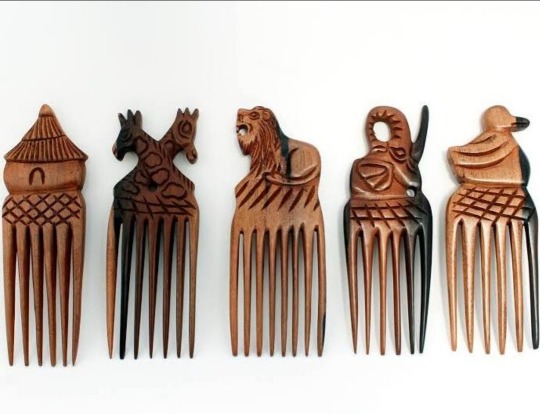
It was designed FOR the people it was designed BY.
I look to my Ancestors, & the traditions that they created. And 3rd Eyes & Chakras were not one of them.
Asé 🙏🏿
204 notes
·
View notes
Photo


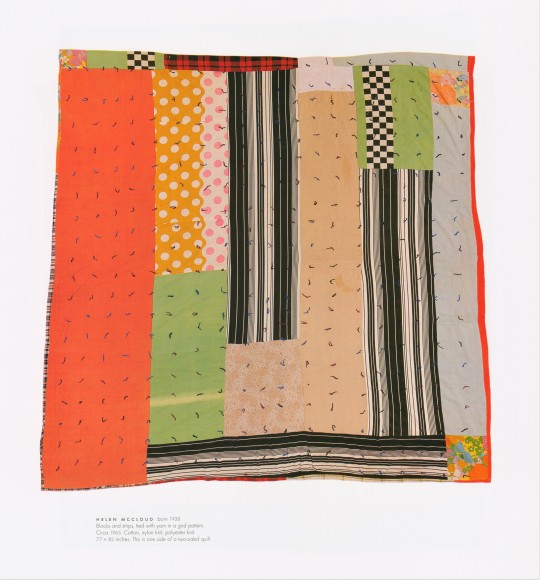
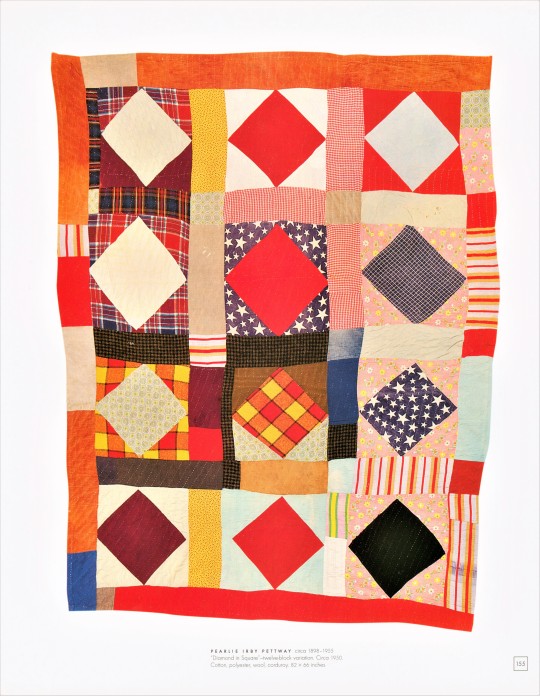
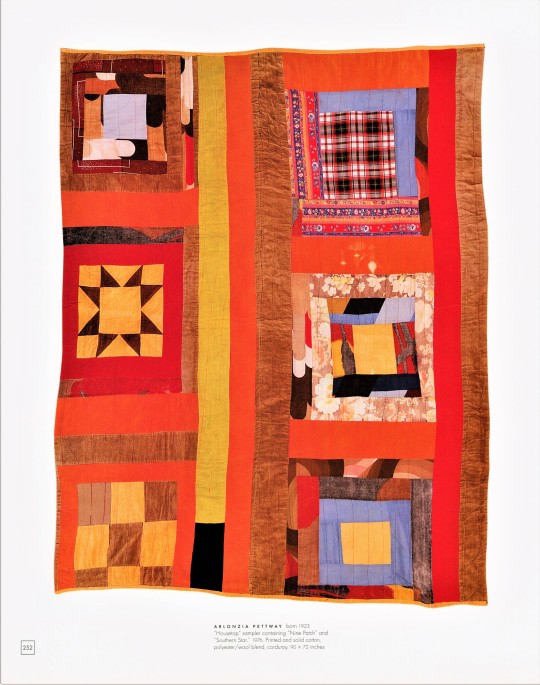



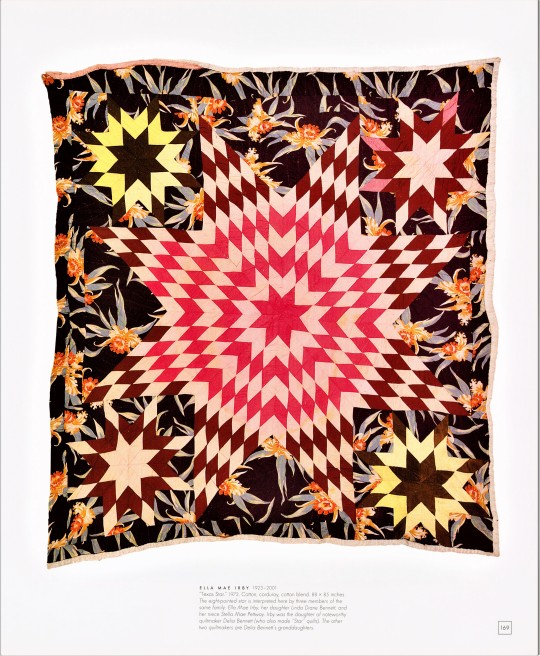
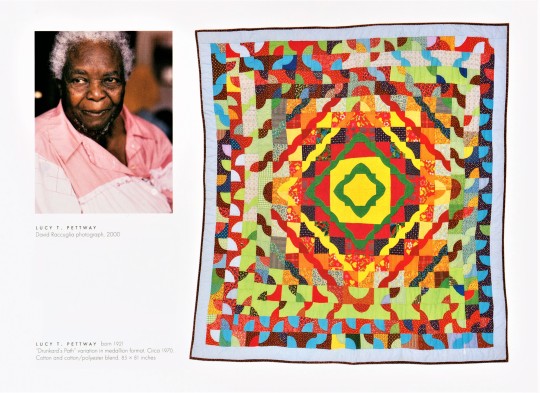
Decorative Sunday
GEE’S BEND QUILTS
Since the 19th century, the women of Gee’s Bend in southern Alabama have created stunning, vibrant quilts. In 2002, folk art collector, historian, and curator William Arnett organized an exhibition entitled "The Quilts of Gee's Bend," which debuted at the Museum of Fine Arts in Houston and later travelled to a dozen other locations across the country, including our own Milwaukee Art Museum (September 27, 2003 - January 4, 2004). This exhibition brought fame to the quilts, and Arnett's foundation Souls Grown Deep Foundation continues to collect and organize exhibitions for Gee’s Bend Quilts.
The images shown here are from Gee’s Bend: The Women and Their Quilts, with essays by John Beardsley, William Arnett, Paul Arnett, and Jane Livingston, an introduction by Alvia Wardlaw, and a foreword by Peter Marzio. The book was published in 2002 by Tinwood Books, Atlanta, and published in conjunction with the 2002 exhibition at the Museum of Fine Arts, Houston. It includes 350 color illustrations and 30 black-and-white illustrations. The dust jacket notes observe:
The women of Gee’s Bend - a small, remote, black community in Alabama - have created hundreds of quilt masterpieces dating from the early twentieth century to the present. . . . [The] quilts carry forward an old and proud tradition of textiles made for home and family. They represent only a part of the rich body of African American quilts. But they are in a league by themselves. Few other places can boast the extent of Gee’s Bends’s artistic achievement, the result of geographical isolation and an unusual degree of cultural continuity. In few places elsewhere have works been found by three and sometimes four generations of women of the same family, or works that bear witness to visual conversations among community quilting groups and lineages.
Our copy is a gift from our friend and benefactor Suzy Ettinger.
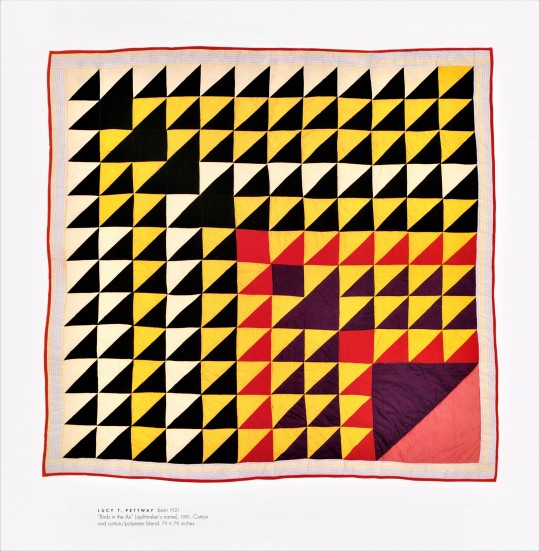
View more Black History Month posts.
View more Decorative Sunday posts.
#Decorative Sunday#Black History Month#decorative plates#decorative arts#quilts#Gee's Bend#quilts of Gee's Bend#Gee’s Bend: The Women and Their Quilts#Museum of Fine Arts in Houston#William Arnett#John Beardsley#Paul Arnett#Jane Livingston#Alvia Wardlaw#Peter Marzio#Tinwood Books#Suzy Ettinger#Black artists#Black women artists
595 notes
·
View notes
Note
have any other ethnicity headcanons for fairy tail characters?
Fairy Tail Characters Ethnicity HCs
I don’t have as much extensive proof as I do for my Erik headcanons post but I will explain my thoughts for why I think certain ethnicities.
Natsu Dragneel : Japanese + Greek? (Because of the clothing style in his past flashback with his biological family)
Erza Scarlet : British + ? - I say British because she reminds me of Lara Croft who in her older days had reddish hair, also English history is big on knights, which Erza is. The other half I can’t tell as I don’t actually know what to think of her father Rung as. He seems like a POC though. (Maybe Mexican?)
Lucy Heartfilia : British / American - Because Lucy’s heritage as a noble it reminds me more of English nobility, but then her characteristics remind me more of american for some reason (it doesn’t help that Lucy looks a lot like Ashley Graham from the original RE4 and she’s American so I am kind of biased there)
Gray Fullbuster : Canada or Serbia (I think that’s mainly because I am making the link of cold countries though). Also if with Serbian I can see Ultear and him coming from similar places)
Gajeel Redfox : Native American (His hair and features remind me of Native Americans and I don’t know he kind of reminds me and looks like of Ratohnhake:ton / Connor from AC3)
Juvia Lockser : Spanish + Russian (Spanish as the name Juvia is Spanish origin and Russian since the ushanka she wears and her clothing style in general)
Jellal Fernandes : Mixed ethnic - Mixed Arab (mainly Levantine Arab) + Latino (Brazilian), but then in my HCs he’s also part Desi too since the name Jellal is most prominent in India (And I want Erik to have a desi bro in CS). And the Arab/South asian idea came from him wearing Kohl/Surma in S1 in the anime.
Ultear Milkovich : Serbian with mixed Central Asian or Kazakh (Again cold countries but since Ultear looks Eurasian but with dark features these countries came to mind. Serbia because apparently the name Milkovich is Serbian origin)
Macbeth/Midnight : English w/Scottish + Irish + Japanese - English/Scottish/Irish is a given since his name ‘Macbeth’ but since his aesthetic is alike to Visual Kei, I see Japanese influence. But I don’t know, I just can see Macbeth with a british accent, maybe that’s just me.
Sorano Aguria : French and Korean/Japanese (I don’t know why I have the French, it just fits me when discussing with my friend @acutemushroom. Korean/Japanese because despite having a Japanese name (her and Yukino) due to her features she gave me kind of Korean vibes for some reason)
Sawyer : English (I can’t explain other than the name. But I thought of Romanian too for some reason, so English + Romanian?)
Richard Buchanan : South African + Scottish? (My only thought for this was because Buchanan I knew it as a last name big in South Africa, and Scottish is probably because of the red hair and ruddy complexion that I know scottish people can have)
Meredy : Irish (I don’t know why, it was hard to think of anything for her)
Kinana : Desi (Since the name Kinana is an urdu name apparently - So Pakistani)
Cana Alberona : Irish + Italian (Guildarts gave me tanned Irish vibes for some reason and Alberona is I believe an Italian name)
Minerva Orland : Chinese + Latina (She wears a Cheongsam and her hair reminds me of Chinese culture but then I see Latina too) BUT, maybe she has Egyptian too and Italian since Minerva (Italian/Latin) but the blue eyeliner/eyeshadow she always has is alike to Malachite powder that was used by ancient egyptians
Laxus Dreyar : Ukrainian + Russian (He gives me eastern europe vibes and also his features) but also since he's Makarov’s grandson he’d have Russian in him
Makarov Dreyar : Russian - (I think his full name is of Russian origin but I can't be sure.)
These are the HCs I have off the top of my head, hope this answers your question!
#fairy tail#fairy tail ethnicity hc#ethnicity hc#natsu dragneel#erza scarlet#lucy heartfilia#gray fullbuster#juvia lockser#gajeel redfox#ultear milkovich#Macbeth (fairy tail)#sorano aguria#meredy fairy tail#jellal fernandes#Sawyer (fairy tail)#Kinana (fairy tail)#richard buchanan#cana alberona#minerva orland#laxus dreyar#makarov dreyar#yamishika's hcs#yami’s thoughts
62 notes
·
View notes
Text
#VoicesFromTheStacks

Image: Self Portrait with cranes from Hope Project (Photo credit: Clarissa Sligh)
The Artist Books of Clarissa Sligh
In honor of Black History Month, we are highlighting artist, writer, and lecturer Clarissa Sligh. Born in Washington, D.C. and raised in Virginia, Sligh is often inspired by cultural, historical, and political events that intersect with moments in her life. Sligh considers these interactions, or “collisions,” between moments in history and events in one’s life to be significant and transformative. One such example of this is detailed in Sligh’s work “It Wasn’t Little Rock,” which discusses desegregation in public schools during the 1960s, a personal topic for Sligh, who was the lead plaintiff at the age of 15 in a school desegregation case.
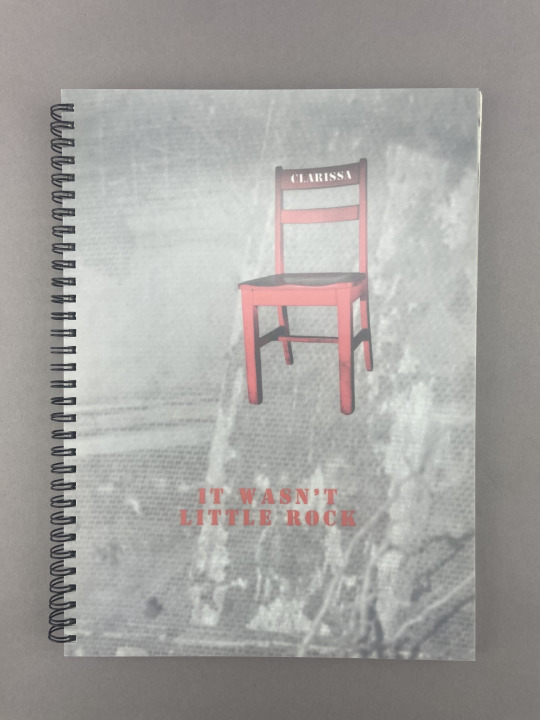
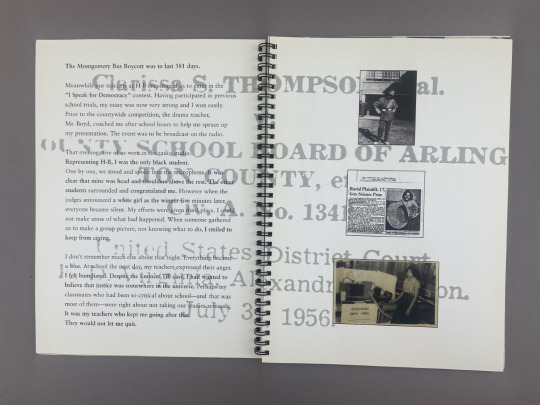
Images: Cover and inside page of "It Wasn't Little Rock" (2005)
A notable example of Sligh’s work and its reference to her personal experiences is her 1988 artist's book titled “What’s Happening with Momma?” Here, the artist engages users to “walk” through rooms of her childhood home, following the steps of accordion-folded strips of paper filled with text detailing memories of her sister’s birth in the home. This is Sligh’s first artist’s book, made through the Women’s Studio Workshop in New York.


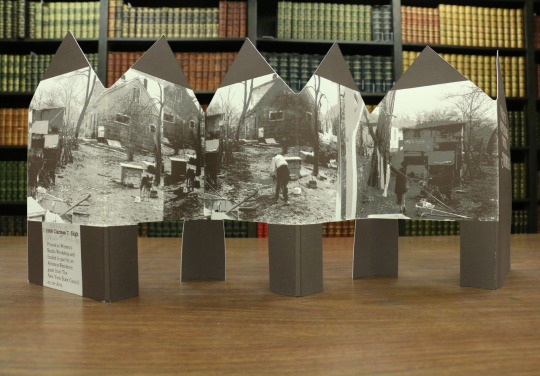
Images: Cover and inside page of "What's Happening with Momma" (1988)
Sligh earned a BS in Mathematics from Hampton Institute in Virginia, a BFA and an MFA in visual arts from Howard University, and an MBA from the University of Pennsylvania. Earlier in her career she had worked at NASA in the manned space flight program, eventually leaving to focus on working as an artist. Her works have been featured all over the world, notably at the Museum of Modern Art in New York, the National Museum of African American History and Culture, and more. To learn more about Sligh and her works, visit the artist’s website.
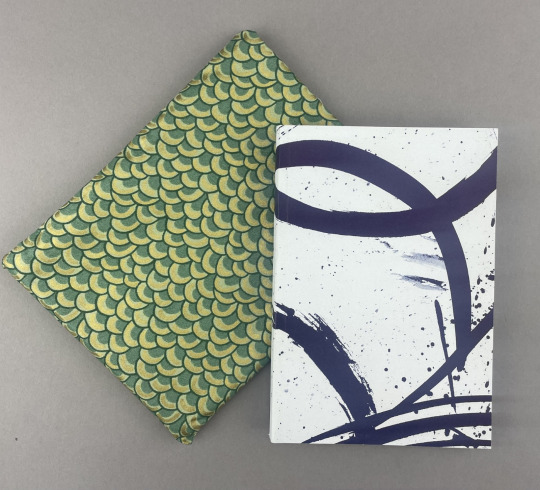

Images: Cloth enclosure, cover and inside page of "Voyage(r): A Tourist Map to Japan" (2000)


Images: Left: Inside page of "Reading Dick and Jane with Me" (1989). Right: Cover and origami crane for "Transforming Hate" (2016).
– Kaylee S., Special Collections Olson Graduate Assistant
#uiowa#libraries#special collections#uiowaspecialcollections#rare books#voicesfromthestacks#artist books#Clarissa Sligh#black history month
67 notes
·
View notes
Text
So you want to learn about Louisiana Voodoo…
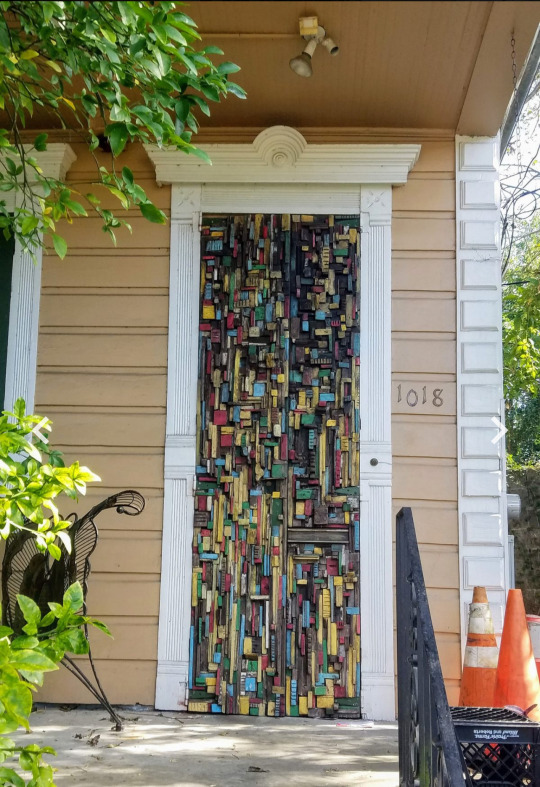
door in New Orleans by Jean-Marcel St. Jacques
For better or worse (almost always downright wrong) Louisiana Voodoo and Hoodoo are likely to come up in any depiction of the state of Louisiana. I’ve created a list of works on contemporary and historical Voodoo/Hoodoo for anyone who’d like to learn more about what this tradition is and is not (hint: it developed separately from Haitian Vodou which is its own thing) or would like to depict it in a non-stereotypical way. I’ve listed them in chronological order. Please keep a few things in mind. Almost all sources presented unfortunately have their biases. As ethnographies Hurston’s work no longer represent best practices in Anthropology and has been suspected of embellishment and sensationalism on this topic. Additionally the portrayal is of the religion as it was nearly 100 years ago- all traditions change over time. Likewise Teish is extremely valuable for providing an inside view into the practice but certain views, as on Ancient Egypt, may be offensive now. I have chosen to include the non-academic works by Alvarado and Filan for the research on historical Voodoo they did with regards to the Federal Writer’s Project that is not readily accessible, HOWEVER, this is NOT a guide to teach you to practice this closed tradition, and again some of the opinions are suspect- DO NOT use sage, which is part of Native practice and destroys local environments. I do not support every view expressed but think even when wrong these sources present something to be learned about the way we treat culture
*Start with Osbey, the shortest of the works. To compare Louisiana Voodoo with other traditions see the chapter on Haitian Vodou in Creole Religions of the Caribbean by Olmos and Paravinsi-Gebert. Additionally many songs and chants were originally in Louisiana Creole (different from the Louisiana French dialect), which is now severely endangered. You can study the language in Ti Liv Kreyol by Guillery-Chatman et. Al.
Le Petit Albert by Albertus Parvus Lucius (1706) grimoire widely circulated in France in the 18th century, brought to the colony & significantly impacted Hoodoo
Mules and Men by Zora Neale Hurston (1935)
Spirit World-Photographs & Journal: Pattern in the Expressive Folk Culture of Afro-American New Orleans by Michael P. Smith (1984)
Jambalaya: The Natural Woman's Book of Personal Charms and Practical Rituals by Luisah Teish (1985)
Eve’s Bayou (1997), film
Spiritual Merchants: Religion, Magic, and Commerce by Carolyn Morrow Long (2001)
A New Orleans Voodoo Priestess: The Legend and Reality of Marie Laveau by Carolyn Morrow Long (2006)
“Yoruba Influences on Haitian Vodou and New Orleans Voodoo” by Ina J. Fandrich (2007)
The New Orleans Voodoo Handbook by Kenaz Filan (2011)
“Why We Can’t Talk To You About Voodoo” by Brenda Marie Osbey (2011)
Mojo Workin': The Old African American Hoodoo System by Katrina Hazzard-Donald (2013)
The Tomb of Marie Laveau In St. Louis Cemetery No. 1 by Carolyn Morrow Long (2016)
Lemonade, visual album by Beyonce (2016)
How to Make Lemonade, book by Beyonce (2016)
“Work the Root: Black Feminism, Hoodoo Love Rituals, and Practices of Freedom” by Lyndsey Stewart (2017)
The Lemonade Reader edited by Kinitra D. Brooks and Kameelah L. Martin (2019)
The Magic of Marie Laveau by Denise Alvarado (2020)
In Our Mother’s Gardens (2021), documentary on Netflix, around 1 hour mark traditional offering to the ancestors by Dr. Zauditu-Selassie
“Playing the Bamboula” rhythm for honoring ancestors associated with historical Voodoo
Voodoo and Power: The Politics of Religion in New Orleans 1880-1940 by Kodi A. Roberts (2023)
The Marie Laveau Grimoire by Denise Alvarado (2024)
Voodoo: An African American Religion by Jeffrey E. Anderson (2024)
#I’ll continue to update as I find more sources#Please be respectful of other people’s religion#Louisiana Voodoo#Louisiana Hoodoo#In the case of authors behind a paywall or whom you do not wish to support I highly recommend your local library#I do not support every view but think even when wrong they present something to be learned about the way we treat culture#Voodoo#Hoodoo#conjure#rootwork#Books
38 notes
·
View notes
Text

Malawi Railways diesel railcar on service to Beira, Dona Anna, Malawi mid 1960s
130 notes
·
View notes
Text
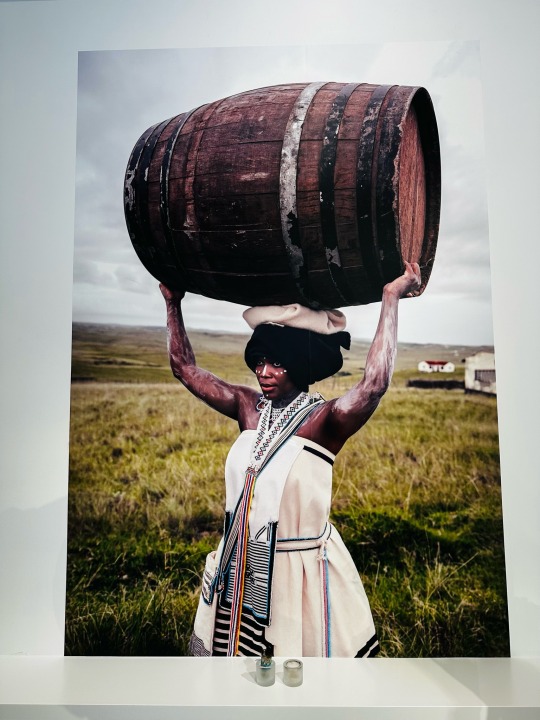


ZIZIPHO POSWA – IINTSIKA ZESIZWE (PILLARS OF THE NATION).
#installation#conceptual#minimal interior#nyc#space#detail#manhattan#time#critic#gallery#galerie56#exhibition#African#culture#photography#visual
1 note
·
View note
Text



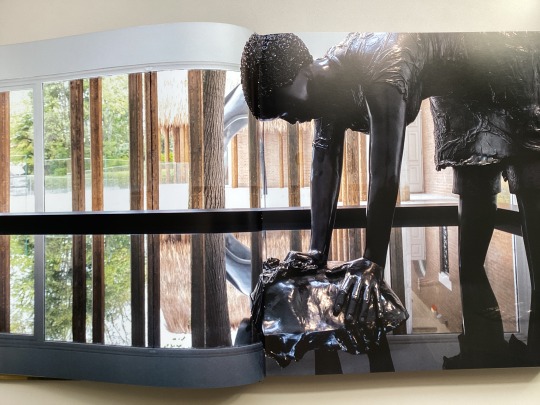
“In order to tell the truth, you need to invent what might be missing from the archive, to collapse time . . . to formally move things around in a way that reveals something more true than fact.”
Simone Leigh (b. 1967) is an American artist whose work focuses on explorations of community, Black feminism, and the traditions and material culture of the African diaspora. Over the past two decades, Leigh has created artwork that situates questions of Black femme-identified subjectivity at the center of contemporary artistic discourse. Her sculpture, video, installation, and social practice explore ideas of race, beauty, and community in visual and material culture. Leigh often draws her concepts and inspirations from anthropological, historical, and colonial archives that represent stereotypical views of black women through a European lens. She creates new forms incorporating her research on these archives with African aesthetics and Black feminist concepts.
In 2022, Leigh was the first black woman to represent the United States in the Venice Biennale.
Image 1: A large head sculpture that is work-in-progress in her studio
Image 2: Untitled, 2022, stoneware
Image 3: Brick House, 2019, bronze
Image 4: Last Garment, detail, 2022, bronze, steel, metal, filtration water pump, water
Simone Leigh
Edited by Eva Respini.
Boston : Institute of Contemporary Art/Boston ; New York : DelMonico Books, [2023]
HOLLIS number: 99157252441903941
#WomensHistoryMonth#SimoneLeigh#BlackWomenArtists#WomenArtists#Sculpture#HarvardFineArtsLibrary#Fineartslibrary#Harvard#HarvardLibrary
18 notes
·
View notes
Text

Finished product first, held by my wonderful spouse. Northshield is a kingdom big on the power of light. Our motto includes illumination as a virtue. We have a star named Griffin's Light. On top of the society A&S badge being a candle, our A&S awards are the Black Flame and Brigit's Flame. Since about year two of my tenure in the SCA I've dreamed of making a lantern scroll to honor that aspect and now I've done two. I'm so grateful to be surrounded by people who inspire me to push my boundaries and make cool art.
As such, these are lantern scrolls for Brigit's Flame awards, the GOA level Northshield arts and science award. One is for my wonderful friend Thegn Samson Muskovich (aka Samii), who does so much for the arts and sciences of the SCA. From metalworking with bronze and silver, to leatherwork and armoring, to teaching about existing as a trans person in the SCA and deep diving into the experience of the Gullah Geechee and making sure we know that the experience of Africans trafficked to America is as period as their resilience and resistance. I'm so proud that he's my cousin in the Choctaw tribe. The second is for the magnificent Dame Katerinka Lvovicha (aka Kat), who received her Brigit's Flame in 2015 but never got the scroll for it. She also does so much for Northshield, especially in the realms of heraldry and scribal arts, and she blasts a path for all Northshielders to feel safe by being extremely proactive about pronouns, cultural touchstones, and literally offering housing and travel assistance to people.

The inspirations for the project include these four lanterns and Morgan Donner's lantern build video. In the top row are two illustrations from period showing lanterns. The red lantern is from Book of Hours, MS M.972 fol. 1r, and has a bit of a splayed shape with a wider base and a turned dome at the top. It also has horn panels that aren't quite perfect fits for each side panel, as evidenced by the uneven horizontal lines. The second lantern, held by a crotchety dragonesque beast, is from Breviary, MS M. 8 fol. 158r and has a flat top with straight sides.
The second row shows two lantern awards made by other SCAdians. The first was made by Brig Ingen Erennaigh for a baronial service award called the Coill's Beacon, and the second is an Award of Arms by Northshield's own Tatiana Melville.
My original plan was actually to make a couple of so-called Viking lanterns like the kind you see all over Etsy. These usually consist of a top and bottom disc of wood, with dowels in between, and parchment or rawhide wrapped around the exterior. Extremely simple, and the parchment provides the perfect scroll text surface, but thanks to Morgan Donner's video, I now know those are dated to the 1800s. The idea of illuminated parchment stuck with me though and I decided to make a lantern more along the lines of the Breviary lantern but with simulated parchment in place of horn panes. I felt this was a good compromise between my original plan and a documentably period shape.
I didn't leave myself enough time to make this scroll, between the shield I made for Crown Tournament and Halloween festivities. Thinking fast, I ran out to my local hardware store for some precut 6 inch rounds. The ones I got have an ahistoric Roman ogee routed into the edge, but they'll add some nice visual detail to the scrolls.

Splitting my poplar side beams to width was vaguely harrowing on my radial arm saw. It would've been better to use my bandsaw but it's really not set up for use yet, so I made a janky jig and stood off to the side.

I was successful, and began the annoying process of carving 24 dowel tips.
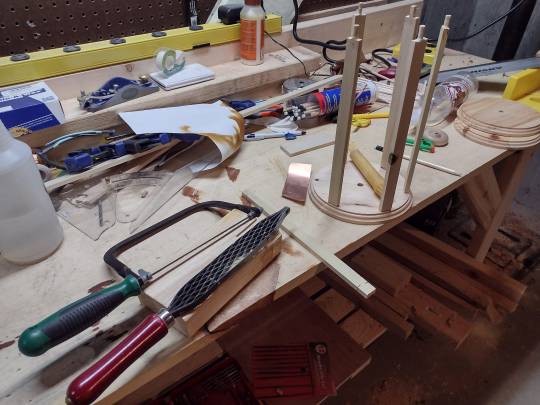
Tools of the trade, and five doweled supports installed in the first base.

The coping saw did a great job of parting off each dowel end.
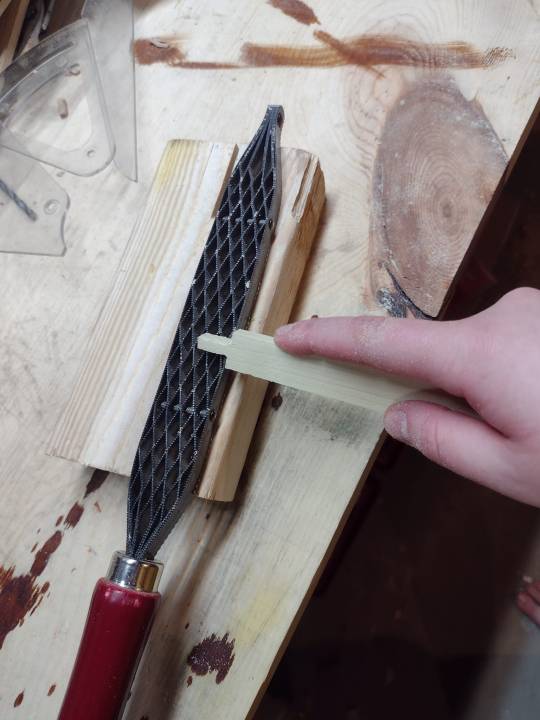
Dog bless the Shinso rasp. This thing makes my woodworking experience so much easier.

I got one set done and checked my progress. This looks really, really good so far.
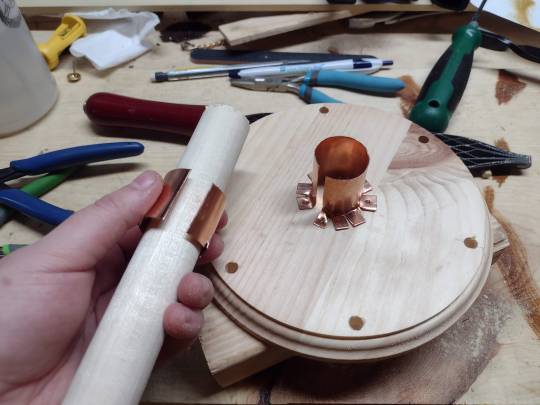
I then grabbed some copper and went to town making the candle holders. I wanted these to have some give for different diameters of candles, including electric candles. These were made entirely off of Morgan Donner's video and aren't based on anything I personally researched, so I can't say anything to their historocity beyond knowing that sheet copper definitely wasn't the material of choice back then. I used a spare fat poplar dowel to form both holders.

I then used sidecutters to make the flanges, and bent them out flat. I used some brass brads to nail the holders to the bases, and pressed them through with my drill press just as I did with the tacks to the targe I made last month.

At this stage I needed to do a test fit, and boy was I happy with the way it looked so far. Now, I must say that this is not enough spacing between the candle and the lantern roof. It'll probably be alright, but it could also get pretty dang hot and risk a fire in there. A shorter candle would be better, but I have a hundred of these beeswax candles so I'm gonna give them away as gifts whenever I can.
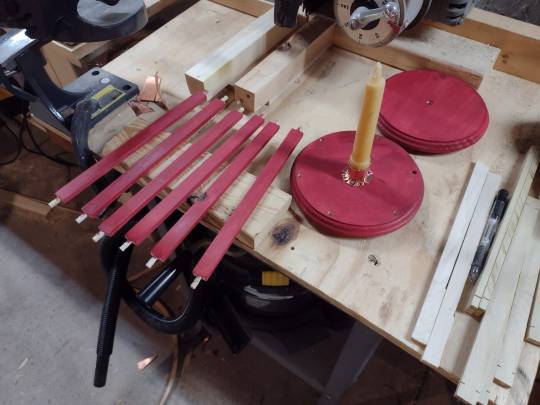
Since the Book of Hours lantern is red and Samii's livery colors are red and gold, I painted his lantern red. I used a few different paints mixed together to achieve this shade, and then I sprayed the whole thing with matte polyurethane sealant.

I decided to make Kat's a nice golden oak color in contrast to the red lantern, based on so many being light colored in the various illustrations and illuminations I saw. It was down between this and painting it blue to match her arms, but I think I'm glad I did two very different finishes. The poplar is so green that the oak stain couldn't really compensate, but it's not bad. This lantern was sealed with finishing wax.
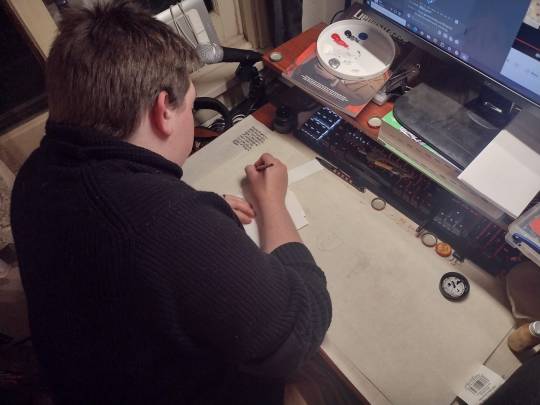
At this point Kim stepped in to get the scrolls done. This is Pergamenata, a perennial favorite of SCA scribes for having a similar surface feel and translucency to animal parchment. Usually I do illumination and word smithing while they just do the hand writing, but this time they took on all three of those tasks, much to my joy.

Here's Kat's scroll panes before color. You can see Kim used a template made off my test fit of the lantern to get the spacing correct. They used Speedball india ink and matched the hand to the calligraphy in CNM XXIII.C.124 Velislavova Bible, which they also took the design of the torch from.

Both scroll panes inked, painted and drying. We chose these scrolls to try tempera paint for the first time and the translucency of the tempera on the translucency of the perg is just so good.

Here's Kat's scroll panels with the oak-stained side supports.

Here's Samii's scroll panels with the red side supports.

The final assembly process. I had to cut the scroll panels into individual panes, because the spacing wasn't perfect. I used wood glue to affix the perg panes to the backside of each support, holding or clamping alternately to keep everything in place as the glue-wet perg curled away from the supports and then uncurled as the adhesive cured. It was a pain in the ass but it worked out. I then had to form two bronze rings for the tops of each lantern, and install hooks and loops to close the back pane, which has one end loose and wrapped around a thin piece of basswood.

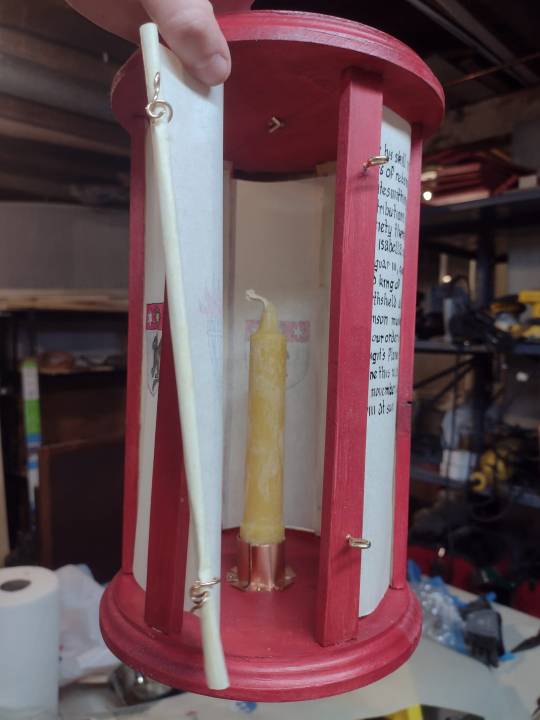

Here is the final assembly completed, showing the door hooks made of bronze and the eyelet screws made of brass. This is not a very historic door shape, but it's what Morgan Donner hacked together for her lanterns and if it worked for her it'll work for me.

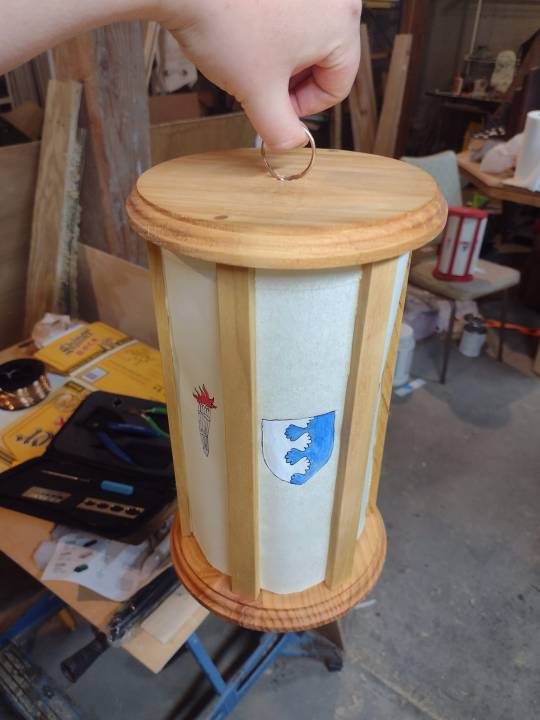
Kat's scroll completed as well, and here's the only view I have of the top suspension ring.


And of course it's not a lantern if you don't see it illuminated. I gave both recipients a beeswax candle and an electric candle, and this photo was taken with the electric candle in place. I had to wrap gaffer tape around the base to make it fit. The electric candle is actually pretty bright! Look at that pretty red paint, and not the fact that the support is slightly angled.
40 notes
·
View notes
Text
Answering questions I get asked as a black person for Black History Month
"Do you get tanned?" Yes, I do. It can take a while but when I get tanned I can get 2 to 3 shades darker. I will admit I don't always notice this until I see my tan lines but I do get tanned.
"Do you get sun burned?" Yes, I do. Even though it's much harder for me I'm not immune to getting a sun burn. I'm still a human with skin and the sun is still a giant cancer beam in the sky. I just don't need the same amount of protection that light skin people do. If it’s bright or hot enough, I will occasionally put on lotion that doubles as sun screen and that'll be all I need for the whole day (and sometimes for the next day). I don’t need to continuously lather myself.
"Are your feet also light?" Yes, they are. This is actually something that everyone has but it's more noticeable on darker skin people like myself but my hands and feet are lighter than the rest of my body.
"Do you blush?" This is actually an interesting question because it's not a universal answer. While I do experience the sensation of blushing (hot cheeks and ears), my face doesn't change shades because I'm too dark. But not everyone is like this. You can see someone with a lighter skin tone blush but it's not beet red but more of an earthly red color. For a visual reference, something like this (hex codes in alt)



"Why are you wearing that headscarf?" For context, before I go to sleep I wear a bonnet (photo for reference, ID in alt)

It’s made of silk and it’s to avoid my hair from falling apart when I sleep. Natural hair requires a lot more work to maintain and nothing will ruin it more than just laying on it for hours. This helps to keep natural hair in the same state and lock in moisture. I remember once when my hair was in an afro, I forgot to wear my bonnet for about a week and my hair was a nightmare. It was matted, tangled, and took forever to comb out.
“Do you prefer being called ‘Black’ or ‘African-American’?” This is also not a universal answer and I do not speak for the entire Black community but please call me Black. White people aren’t called “European-Americans” so why should we be calling Black people “African-Americans.” I’m from the United States, my parents are from the United States, my parents parents are from the United States, I don’t have a single drop of blood from Africa. I am Black, Elon Musk is African-American.
But once again, I do not speak for everyone in the Black community. Some people do like “African-American” more as it does make them feel more connected to their culture and history. Some people just don’t care. There’s no one answer to this but this is my answer.
"Can I touch your hair?" NO! Unless you're related to me, my hair stylist, or if it's a matter of life and death, do not touch my hair.
24 notes
·
View notes
Text
So I know this may be “controversial” but I’m so sick of seeing people complain about the new Avatar movie and try to cancel it over the most ridiculous things.
For starters… they are 10FT tall blue aliens with 3 fingers living on an alien planet that takes about 5 years to get too, from the future. How are people trying to make this about the human race living today in our times?
People complaining because Jake has dreadlocks… it’s called ✨Na’vi culture✨ on earth it may be an African cultural thing, but they aren’t on earth, they are on Pandora where the Na’vi are an alien race that believe it or not, do in fact have their own culture. Besides they also have a giant braid that has stuff inside of it…
People mad because they think Jake is trying to be “indigenous” when he’s “just some white dude pretending” like bro… it’s called acculturation and assimilation. What else would you expect him to do? It’s like getting mad at a European trying to embrace an Asian culture because his partner and kids are Asian and live in an asian country…
And finally, the people who are for some reason getting triggered because Avatar 3 will have an element of the new Ash tribe and Fire Na’vi saying that James Cameron is “copying” Avatar the last air bender. There are so many ways to break this down but here’s two: 1 is about an alien planet with 10FT tall blue people that have glowing dots on their skin, the other is about a bunch of people controlling elements… (essentially) how are people making connections here?
The other way to break this down is: Pandora is a lot like earth, it’s has ✨biomes✨ and different ✨environments✨ right. So there’s this thing called ‘adapting to your environment’. The Omatikaya is Forest Na’vi which is aliens that live in the forest. The Metkayina is Reef and Sea Na’vi which are aliens that live by and in the sea… the fire Na’vi (from what I’ve heard) live close to or in a volcano… they don’t control the elements they simply live in environments to which they have adapted to and hence the reason they are given different names.
From the sounds of things Pandora has reefs, forests, mountains, deserts, snow(?) and is again just like earths structure and environments. Which makes it so much better than all these other futuristic outer space movies where there are planets that seem to be only 1 biome and earth is the ONLY planet that has multiple.
On earth, people who live or come from Europe are called European. People who live or originate from Africa, are called African. People who originate from Asia, are called Asian. On Pandora, Na’vi who come from the forest are the Omatikaya people. Na’vi who come from the reefs or oceans are the Metkayina people.
So before you all start raising your pitchforks and torches claiming “cUltUraL apProPriation” about 10FT tall blue aliens from outer space, take a second to realise how dumb it sounds. If you didn’t like the movie, that’s okay, but don’t ruin it for the rest of us. It seems today that no one can enjoy something without someone criticising it and ruining it for the ones who just want to watch a cool movie with beautiful aesthetics and nice visuals…
To anyone who’s made it this far into the rant, I appreciate it. To those who don’t agree, I don’t care but feel free to disagree all you want, and to those who agree, again I don’t really care but cool.
#avatar thought#avatar the last airbender#avatar thoughts#avatar#avatar the way of water#avatar 2#jake sully#james cameron#na’vi#pandora#rants
165 notes
·
View notes